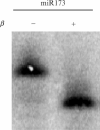Approaches for studying microRNA and small interfering RNA methylation in vitro and in vivo
- PMID: 17720483
- PMCID: PMC3574582
- DOI: 10.1016/S0076-6879(07)27008-9
Approaches for studying microRNA and small interfering RNA methylation in vitro and in vivo
Abstract
The biogenesis of microRNAs (miRNAs) in plants is similar to that in animals, however, the processing of plant miRNAs consists of an additional step, the methylation of the miRNAs on the 3' terminal nucleotides. The enzyme that methylates Arabidopsis miRNAs is encoded by a gene named HEN1, which has been shown genetically to be required for miRNA biogenesis in vivo. Small interfering RNAs (siRNAs) are also methylated in vivo in a HEN1-dependent manner. Our biochemical studies demonstrated that HEN1 is a methyltransferase acting on both miRNAs and siRNAs in vitro. HEN1 recognizes 21 to 24 nt small RNA duplexes, which are the products of Dicer-like enzymes, and transfers a methyl group from S-adenosylmethionine (SAM) to the 2' OH of the last nucleotides of the small RNA duplexes. Here we describe methods to characterize the biochemical activities of the HEN1 protein both in vitro and in vivo, and methods to analyze the methylation status of small RNAs in vivo.
Figures




Similar articles
-
HEN1 recognizes 21-24 nt small RNA duplexes and deposits a methyl group onto the 2' OH of the 3' terminal nucleotide.Nucleic Acids Res. 2006 Jan 30;34(2):667-75. doi: 10.1093/nar/gkj474. Print 2006. Nucleic Acids Res. 2006. PMID: 16449203 Free PMC article.
-
Methylation protects miRNAs and siRNAs from a 3'-end uridylation activity in Arabidopsis.Curr Biol. 2005 Aug 23;15(16):1501-7. doi: 10.1016/j.cub.2005.07.029. Curr Biol. 2005. PMID: 16111943 Free PMC article.
-
siRNAs compete with miRNAs for methylation by HEN1 in Arabidopsis.Nucleic Acids Res. 2010 Sep;38(17):5844-50. doi: 10.1093/nar/gkq348. Epub 2010 May 6. Nucleic Acids Res. 2010. PMID: 20448024 Free PMC article.
-
MicroRNA biogenesis and function in plants.FEBS Lett. 2005 Oct 31;579(26):5923-31. doi: 10.1016/j.febslet.2005.07.071. Epub 2005 Aug 9. FEBS Lett. 2005. PMID: 16144699 Free PMC article. Review.
-
Unique 2'-O-methylation by Hen1 in eukaryotic RNA interference and bacterial RNA repair.Biochemistry. 2012 May 22;51(20):4087-95. doi: 10.1021/bi300497x. Epub 2012 May 14. Biochemistry. 2012. PMID: 22564049 Review.
Cited by
-
Functional mapping of the plant small RNA methyltransferase: HEN1 physically interacts with HYL1 and DICER-LIKE 1 proteins.Nucleic Acids Res. 2015 Mar 11;43(5):2802-12. doi: 10.1093/nar/gkv102. Epub 2015 Feb 12. Nucleic Acids Res. 2015. PMID: 25680966 Free PMC article.
-
Intergenic transcription by RNA polymerase II coordinates Pol IV and Pol V in siRNA-directed transcriptional gene silencing in Arabidopsis.Genes Dev. 2009 Dec 15;23(24):2850-60. doi: 10.1101/gad.1868009. Genes Dev. 2009. PMID: 19948763 Free PMC article.
-
Piwi-interacting RNA (piRNA) expression patterns in pearl oyster (Pinctada fucata) somatic tissues.Sci Rep. 2019 Jan 22;9(1):247. doi: 10.1038/s41598-018-36726-0. Sci Rep. 2019. PMID: 30670741 Free PMC article.
-
BmNPV p35 Reduces the Accumulation of Virus-Derived siRNAs and Hinders the Function of siRNAs to Facilitate Viral Infection.Front Immunol. 2022 Feb 18;13:845268. doi: 10.3389/fimmu.2022.845268. eCollection 2022. Front Immunol. 2022. PMID: 35251046 Free PMC article.
-
Methyltransferase-directed orthogonal tagging and sequencing of miRNAs and bacterial small RNAs.BMC Biol. 2021 Jun 22;19(1):129. doi: 10.1186/s12915-021-01053-w. BMC Biol. 2021. PMID: 34158037 Free PMC article.
References
Publication types
MeSH terms
Substances
Grants and funding
LinkOut - more resources
Full Text Sources
Other Literature Sources
Molecular Biology Databases
Research Materials

